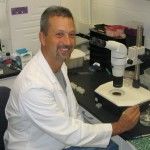The nematode C. elegans is both genomically-defined and genetically-tractable, and has emerged as a leading model system for the study of integrative physiology. In fact, more than 750 genes or ~4% of the worm genome encode proteins involved in ATP-dependent, secondary active, and passive channel-mediated transport processes suggesting that the electrical properties of individual cells could be conserved across species. My laboratory uses C. elegans as a model system to study epithelial membrane transport through a variety of novel approaches that are only possible in this well-characterized organism.
The following images are from our 2002 paper describing the nhx gene family in worms. Each schematic is color-coded to represent cells and organs that express a particular nhx isoform. Click on the Button or Nematode area to view the nhx gene summary at Worm Base (www.wormbase.org)
[kml_flashembed publishmethod=”static” fversion=”8.0.0″ movie=”http://www.nehrkelab.com/wp-content/uploads/nematode_round_2.swf” width=”450″ height=”300″ targetclass=”flashmovie”] [/kml_flashembed]
[/kml_flashembed]
Click on the Button or Nematode area to view the nhx gene summary at Worm Base (www.wormbase.org)
[kml_flashembed publishmethod=”static” fversion=”8.0.0″ movie=”http://www.nehrkelab.com/wp-content/uploads/nematode_parts_3.swf” width=”555″ height=”300″ targetclass=”flashmovie”]
In particular, since nematodes are transparent, fluorescence-based measurements of ion flux in an intact animal can be readily accomplished. Fluorescence Resonance Energy Transfer (FRET) is used to look at Ca2+-signaling with genetically encoded “chameleon” proteins that fuse two Green Fluorescent Protein (GFP) isoforms linked by a calmodulin calcium-binding domain. In addition, a pH-sensitive variant of GFP, “pHluorin”, is used via dual excitation ratio imaging to monitor cellular pH changes. Real-time fluorescent imaging, in combination with reverse genetics and a vast repertoire of readily available mutant strains, allows us to assess the contribution of membrane transport proteins to cellular homeostasis under normal physiological and stress-related conditions at single cell resolution in an intact, living organism.
For example, we have shown that knockdown of NHX-2, a Na-H exchanger expressed exclusively on the apical membrane of intestinal epithelial cells, results in acidification of the intestinal intracellular pH by 0.25 units. In addition, we have demonstrated that the activity of NHX-2 is indirectly coupled to that of OPT-2, the intestinal H+-oligopeptide cotransporter. Genetically, ablation of these two transport processes results in similar loss-of-function phenotypes: these include hallmarks of starvation, as well as an increase in the lifespan of the nematode.
The use of C. elegans as a model system to study the molecular hallmarks of senescence has garnered significant attention recently based upon findings that specific individual proteins can dramatically alter nematode adult lifespan, with no apparent loss of health or vitality. Characteristically, longevity arises in nematodes via three different venues: 1.) caloric restriction, 2.) neuroendocrine signaling pathways that recognize nutrient availability, and 3.) mitochondria respiratory chain function. In general, the molecular components and mutational phenotypes of these pathways are conserved from worm to man. We hypothesize that pHi acts as a synergistic messenger, and provides a metabolic context through which the actions of diverse cellular and trans-cellular signaling pathways are interpreted. One focus of our laboratory is to determine how intracellular pH influences the metabolic pathways that lead to longevity, and to identify new genes that control acid-base homeostasis in the intestine.
Bones and stones: calcium homeostasis, hypercalciuria, and bone mineral balance
Calcium homeostasis occurs through three major pathways: intestinal calcium absorption, renal calcium reabsorption, and calcium buffering through bone (de)mineralization. Our laboratory, in collaboration with Dr. David Bushinsky, Chief of Nephrology, uses two model systems in combination to study these processes.
The first of these is the Genetic Hypercalciuric (GHS) rat strain. This strain has been derived from selective inbreeding of the most hypercalciuric Sprague-Dawley (SD) rats for >65 generations. Urine calcium excretion of these GHS rats is ~8-10 fold higher than the parental SD strain. Over an 18 wk period the GHS rats spontaneously and progressively form kidney stones. Abnormalities have been observed in all three major facets of calcium homeostasis, and quantitative trait loci analysis has suggested between seven and eleven separate alleles are responsible for the hypercalciuric trait.
The second of these uses primary mouse embryonic calvarial cells in culture. Bones represent the main reservoir of proton buffering capacity in the body. Metabolic acidosis initially induces physicochemical dissolution of bone mineral resulting in buffering followed by cell-mediated increased bone resorption and decreased bone formation. Demineralization can also result in dramatic calcium release and hypercalciuria. Metabolic acidosis can alter the expression of a number of genes in osteoblasts and increases osteoblastic PGE2 secretion, which leads to an increase in RANK-L expression and induces osteoclastic bone resorption.
In order to globally compare changes in gene expression either in the kidney of the GHS rat, or in bone induced by metabolic acidosis, we have used high-density oligonucleotide microarray analysis. A comparison between individual hybridizations using a two class unpaired t-test led in each case to the identification of nearly 150 genes with a minimum change of 2-fold and p-values of <0.05, many of whose expression levels were validated by quantitative RT-PCR and/or Northern analysis.
We anticipate that the approach described here will allow us to determine the fundamental alterations in gene expression that first, are related to calcium oxalate and or calcium phosphate stone formation in the GHS rat, and second, that underlie the cell-mediated net calcium efflux from bone. Understanding these mechanisms may help us understand further the pathogenesis of stone formation in man, as well as allow us to devise strategies to preserve bone mineral during acidosis while maintaining its important proton buffering properties.
